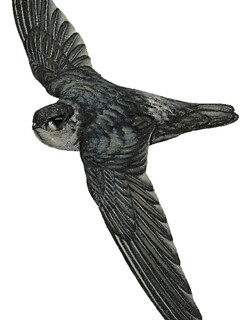White-nest Swiftlet / Aerodramus fuciphagus

White-nest Swiftlet
SCI Name:
Protonym: Hirundo Fuciphaga K.Vet.Akad.NyaHandl. 33 p.153
Taxonomy: Caprimulgiformes / Apodidae / Aerodramus
Taxonomy Code: ednswi1
Type Locality: Java.
Author: Thunberg
Publish Year: 1812
IUCN Status:
DEFINITIONS
AERODRAMUS
(Apodidae; Ϯ Himalayan Swiftlet A. brevirostris innominatus) Gr. αηρ aēr, αερος aeros air; -δρομος -dromos -racer < τρεχω trekhō to run; "A.—Tarsus more or less feathered (subgenus Aerodramus). ... AERODRAMUS, 6 subgenus nov. Chars. subgen.— Similar in proportions to the subgenus Collocalia, but tarsus more or less feathered. Type.— Collocalia innominata Hume. ... 6 αηρ, aer; δραμειν, cursare." (Oberholser 1906); "Aerodramus Oberholser, Proc. Acad. Nat. Sci. Phila., 58, 1906, p. 179 (in key), p. 182. Type, by original designation, Collocalia innominata Hume." (Peters, 1940, IV, p. 220).
Synon. Zoonava.
fuciphaga / fuciphagus
Gr. φυκος phukos seaweed; -φαγος -phagos -eating < φαγειν phagein to eat.
● Ray 1678, quoting Jacob Bontius, wrote, “In the Sea-coast of the Kingdom of China, a sort of small particoloured birds, of the shape of Swallows, at a certain season of the year, viz. their breeding time, come out of the midland Country to the Rocks; and from the foam or froth of the Sea-water dashing and breaking against the bottom of the Rocks gather a certain clammy, glutinous matter, perchance the Sperm of Whales, or other fishes, of which they build their Nests ...These Nests the Chinese pluck from the Rocks, and bring them in great numbers into the East Indies to sell; which are esteemed by gluttons great delicacies, who dissolving them in Chicken or Mutton broth, are very fond of them, preferring them far before Oysters, Mushromes, or other dainty and licorish morsels which most gratify the Palate” (Aerodramus).
SUBSPECIES
White-nest Swiftlet (inexpectatus)
SCI Name: Aerodramus fuciphagus inexpectatus
inexpecta / inexpectata / inexpectatum / inexpectatus / inexpectus / inexspectata / inexspectatus
L. inexspectatus unexpected, surprising, unlooked for < in- not; exspectatus awaited, expected < exspectare to await.
● “In view of the stability shown by Arremonops conirostris conirostris through a wide area, the appearance of this form so near the type-locality of that race is surprising and inexplicable” (Chapman 1914) (subsp. Arremonops conirostris).
● “It certainly was unexpected to find such a striking and hitherto unknown species on Guadalcanar, and this and the discovery of other new forms on the island shows that the ornithological exploration of Guadalcanar has hitherto been very imperfect” (Hartert 1929) (Guadalcanaria).
● “et necata inexpectatum nobis gaudium dedit novae speciei, ante nunquam visae” (Forster 1844) (Pterodroma).
● "Named both for the unexpected nature of its distribution, being restricted to two provinces of Ghana, and the fact that there are no obvious geographic barriers that separate it from two other members of the genus" (Voelker et al. 2016) (subsp. Stiphrornis erythrothorax).
● “On examining a large series of birdskins collected in the northern parts of Celebes and presented to the Leyden Museum by S. C. I. W. van Musschenbroek, Esq., I was quite astonished to find, that there exists in the Minahassa, beside Strix [= Tyto ] Rosenbergii, another large species of Barn-owl, very different as well from Strix Rosenbergii as from all the other known species” (Schlegel 1879) (Tyto).
White-nest Swiftlet (vestitus)
SCI Name: Aerodramus fuciphagus vestitus
vestita / vestitus
L. vestitus clothed, adorned < vestire to adorn < vestis garment, clothing.
White-nest Swiftlet (perplexus)
SCI Name: Aerodramus fuciphagus perplexus
perplexa / perplexus
L. perplexus confused, obscure, ambiguous < plexus plaited, interwoven.
White-nest Swiftlet (fuciphagus)
SCI Name: Aerodramus fuciphagus fuciphagus
fuciphaga / fuciphagus
Gr. φυκος phukos seaweed; -φαγος -phagos -eating < φαγειν phagein to eat.
● Ray 1678, quoting Jacob Bontius, wrote, “In the Sea-coast of the Kingdom of China, a sort of small particoloured birds, of the shape of Swallows, at a certain season of the year, viz. their breeding time, come out of the midland Country to the Rocks; and from the foam or froth of the Sea-water dashing and breaking against the bottom of the Rocks gather a certain clammy, glutinous matter, perchance the Sperm of Whales, or other fishes, of which they build their Nests ...These Nests the Chinese pluck from the Rocks, and bring them in great numbers into the East Indies to sell; which are esteemed by gluttons great delicacies, who dissolving them in Chicken or Mutton broth, are very fond of them, preferring them far before Oysters, Mushromes, or other dainty and licorish morsels which most gratify the Palate” (Aerodramus).
White-nest Swiftlet (dammermani)
SCI Name: Aerodramus fuciphagus dammermani
dammermani
Dr Karel Willem Dammerman (1885-1951) Dutch zoologist, botanist, collector in Java 1910-1939 (subsp. Aerodramus fuciphagus, Myzomela, syn. Pericrocotus miniatus, subsp. Psittacula alexandri, subsp. Ptiloprora erythropleura).
White-nest Swiftlet (micans)
SCI Name: Aerodramus fuciphagus micans
micans
L. micans, micantis glittering, twinkling, glowing < micare to sparkle.
UPPERCASE: current genus
Uppercase first letter: generic synonym
● and ● See: generic homonyms
lowercase: species and subspecies
●: early names, variants, mispellings
‡: extinct
†: type species
Gr.: ancient Greek
L.: Latin
<: derived from
syn: synonym of
/: separates historical and modern geographic names
ex: based on
TL: type locality
OD: original diagnosis (genus) or original description (species)












